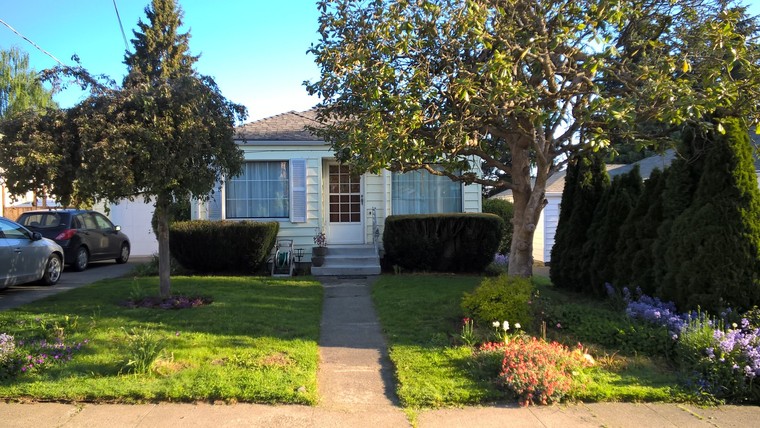



The 4th of July is a day of patriotism, revelry, and family. It gives friends and families an opportunity to gather for a day of relaxation, celebration, and of course, food! There’s nothing quite as quintessentially “summer” as a 4th of July cookout. With that in mind, we decided to look at a few ways to best set up this tastiest of traditions.
The Traveling Picnic
The Extended Table
The Couple’s Night

If you have ever had the responsibility of hosting a get-together, you probably know that it can be a daunting task. Between barbecuing, decorating, and general mayhem, the three-day weekend can feel like its own brand of work. To ease those stresses, we’ve gathered up a few of our favorite DIY traditions that can make everyone’s lives easier. Who knows, you might even have a little fun with them!
Make decoration creation a family event
If your attic shelters a full array of patriotic decorations, it may be no trouble for you to adorn your home appropriately. For the rest of us, here are some family-friendly options for last minute party décor.

Credit: dreamingindiy.com
It’s the little things

Credit: zullily.com
Help nature help you

Credit: Kathy Quillian

So basically, when you have a baby and wife and a career, your home reno slows down a little when your extended family flies back to their respective time zones. Last month, we shared about that pesky 15% of a project that gets left undone. And maybe we still haven’t fixed the grout line in the shower but… we did start a new project! Cleaning up the yard!
Did you know that gardening tools are really expensive? I didn’t. We even priced out what it would cost to have a landscaper come every two weeks just to mow and edge our front and back yard (which would leave us to the weeding, sweeping, etc.) but alas… that is also expensive (about $100 per month). So… Hi-ho, hi-ho, it’s off to Home Depot we go…

Seven Yard Tools All First Time Home Buyers Need:
Lawnmower: Self-propelled so you don’t have to work as hard. Just being real. Our lot is about 7,000 square feet so there’s a whole lot of other things I will do to break my back. Mowing the yard doesn’t have to make the cut (the cut… because it’s a lawn mower… get it?) $399 + gasoline (verses $150 for a bagless push mower… ain’t nobody got time for that.)

Weed-eater: Not just for trimming weeds but more for making the edges of things look more like edges rather than wobbly overgrown lines. It basically gets to the stuff your mower can’t. My dad advised we buy a gas-powered trimmer – he said they last longer and can be more powerful. A little more tricky to start though and more maintenance. I guess we could have gone either way. Who knew gardening would be such a gamble? No wonder my wife loves to garden. She also loves the casino. $119 + gasoline (Sorry, environment!)
Hose Reel: Speaking of my wife, I called Jenn from Home Depot and told her that I had found the perfect solution to our front yard hose, all coiled up on the ground. I had found a $70 hose reel/box. It was the prettiest hose box I had ever seen. My wife said that spending $70 on a plastic hose box may be a little extravagant so we met in the middle and purchased this $30 reel that seems to do the trick.

Gardening Gloves: Protective gloves are probably the cheapest thing on this list… yet we have not bought them. After paying over $100 for literal dirt to fill our raised garden boxes, I guess some luxury had to be sacrificed. $3.98/pair which is less than my typical triple shot Americano (which is a luxury I cannot part with.)
Hedge Trimmer: I haven’t used ours yet as my wife has taken up hedge trimming to express herself artistically. The previous owner of our 1940s fixer was really into her yard and planted some really cool stuff over the last 65+ years. But as she aged, the yard was less tended to and some of the larger bushes took on a life of their own. This trimmer does the trick. I recently asked Jenn to commission a topiary of our dog, Whiskey. She declined. $49.97 for a corded trimmer.

Push Broom: Good for sweeping up the big mess you make when you’re trimming stuff. I love that ours is called the “Quickie Bulldozer.” Doesn’t that just radiate power and sweeping efficiency? $9.98 well spent.
Blower/Vacuum: I experienced the thrill of my lifetime when I realized that our electric leaf blower was also a vacuum! Perfect for sucking up all the lawn clippings left behind from the weed eater. It puts that Quickie Bulldozer to shame. It’s got a max air speed of 250 MPH for $63.21. Enter manly grunt akin to Tim “The Tool Man” Taylor.


The process of purchasing a home directly from a lender can be long and arduous, but could very well be worth it in the end. If you have your sights on a particular home or are looking to find a deal on your first, working directly with the lender may be your only option. Purchasing a bank-owned home is not for the faint of heart, here are some tips for negotiating the REO process:
1. Be prepared: The condition of bank-owned properties are often poor and hard to show. Past owners may have departed on bad terms, leaving the home in poor condition with foul smells, missing appliances, wires taken from breakers, gas fireplaces gone, even bathrooms without toilets and sinks.
2. Understand the costs: Maintenance or repairs may be necessary, since these homes have been vacant for an unknown period of time–sometimes months or years. Keep in mind, when they were occupied the owners could have been under a financial hardship, preventing them from doing regular seasonal care or repairs when needed. Remember as well that the bank is trying to sell the house immediately, so you will receive a financial break in the price rather than a willingness to negotiate on the maintenance and repair issues.
3. Accept the unknown: In traditional real estate transactions, homeowners fill out Form 17 regarding important information about the history of the house. A bank owned home is either exempt or marked with “I don’t know” throughout the document. Not having the accuracy of this 5-page disclosure form could leave you with a lot of unanswered questions on the history of the home.
4. Know what is non-negotiable: The pricing on the house may not get much lower. Some of these properties can be “a dream come true” if you get them at an amazing price, or they could be your worst nightmare. Do your due diligence researching any property, and conduct all necessary inspections to safeguard yourself. Some major repairs may be negotiable, but will likely not reduce the home price.
5. Make a clean offer: The higher the price you can offer, the better. Include your earnest money, keep contingencies to a minimum, and suggest a reasonable closing date. The simpler your offer is, the higher chance you have of the bank accepting your offer or countering in a reasonable time period.
6. Be patient: Consult with a professional who handles bank owned home purchases to help you negotiate the pathway to homeownership. The process of purchasing a bank-owned, foreclosed or short-sale home is typically longer than a typical real estate sale.
Sweet home in a desirable, quiet Loveland location! Gorgeous engineered wood floors, fresh paint, fresh baseboards and nice kitchen updates make this a fantastic move in ready home. Relax in the cool lower level which includes a large rec room, an updated bathroom with a bedroom and an additional room, could be a 4th bedroom. Includes a large yard with two outdoor entertaining decks in back, not to mention mature trees, some even bearing fruit!
Contact Casey Brown for more information or click below to view the photos and details, including price.
Condominium homes are a great, low-maintenance choice for a primary residence, second home, or investment property. This alternative to the traditional single-family home has unique issues to consider before buying, as well as unique benefits. Here’s some background information to help you decide whether purchasing a condo is a good match for you.
Increasingly, condos are not just for first-time homebuyers looking for a less expensive entry into the housing market. Empty-nesters and retirees are happy to give up mowing the lawn and painting the house. Busy professionals can experience luxury living knowing their home is safe and well-maintained while they are away on business. If you are considering buying a condominium for a home, here are a few things you should know:
Condominium basics:
With condominiums, you own everything in your unit on your side of the walls. Individual owners hold title to the condominium unit only, not the land beneath the unit. All owners share title to the common areas: the grounds, lobby, halls, parking areas and other amenities. A homeowners’ association (HOA) usually manages the complex and collects a monthly fee from all condominium owners to pay for the operation and maintenance of the property. These fees may include such items as insurance, landscape, and grounds upkeep, pool maintenance, security, and administrative costs.
The owners of the units in a condominium are all automatic members of the condo association. The association is run by a volunteer Board of Directors, who manage the operations and upkeep of the property. A professional management company may also be involved in assisting the board in their decisions. The condo association also administers rules and regulations designed to ensure safety and maintain the value of your investment. Examples include whether or not pets are allowed and the hours of use for condominium facilities, such as pools and work-out rooms. Should a major expense occur, all owners are responsible for paying their fair share of the expense.
The pros and cons of condominium living:
The condominium lifestyle has many benefits, but condominium ownership isn’t for everyone. Part of it depends on your lifestyle. Condominium living may not be optimum for large families with active kids. The other factor is personal style. By necessity, condominium associations have a number of standardized rules. You need to decide whether these regulations work for you or not. Here are some points to keep in mind if you’re considering condominium living.
Cost: Condominium homes typically cost less than houses, so they’re a great choice for first-time buyers. However, because condominiums are concentrated in more expensive locations, and sizes are generally smaller than a comparable single-family home, the price per square foot for a condominium is usually higher.
Convenience: People who love living in condominiums always cite the convenience factor. It’s nice to have someone else take care of landscaping, upkeep, and security. Condominium homes are often located in urban areas where restaurants, groceries, and entertainment are just a short walk away.
Luxury amenities: May condominiums offer an array of amenities that the majority of homeowners couldn’t afford on their own, such as fitness centers, clubhouses, wine cellars, roof-top decks, and swimming pools. Lobbies of upscale condominiums can rival those of four-star hotels, making a great impression on residents.
Privacy: Since you share common walls and floors with other condominium owners, there is less privacy than what you’d expect in a single-family home. While condominiums are built with noise abatement features, you may still occasionally hear the sound of your neighbors.
Space: With the exception of very high-end units, condominiums are generally smaller than single-family homes. That means less storage space and often, smaller rooms. The patios and balconies of individual units are usually much smaller as well.
Autonomy: As a condominium owner, you are required to follow the laws of the associations. That means giving up a certain about of control and getting involved in the group decision-making process. Laws vary greatly from property to property, and some people may find certain rules too restrictive. If you long to paint your front door red or decorate your deck with tiki lanterns, condominium living might not be for you.
Things to consider when you decide to buy:
Condominium homes vary from intimate studios to eclectic lofts and luxury penthouses. The right condominium is the one that best fits your lifestyle. Here are a few questions to ask to determine which condominium is right for you.
How will you use it?
Will your condominium be your primary residence? A second home? An investment property? While a studio may be too small for a primary residence, it might be a perfect beachfront getaway. Also, consider how your lifestyle may change over the next five to seven years. If you are close to retirement, you may want to have the option of turning a vacation condominium into your permanent home.
Where would you like to live?
Some people love the excitement and sophistication of urban living. Others dream of skiing every weekend. Whether it’s the sound of the surf or the lure of the golf course, a condominium home affords you the ability to live a carefree lifestyle in virtually any setting.
What amenities are most important to you?
The variety of condominium amenities increases each year. Decide what you want, and you can be assured of finding it. Most urban and resort condominiums have an enticing array of extras, from spas to movie screening rooms to tennis courts.
What are your specific needs?
Do you have a pet? Some associations don’t allow them; others have limitations on their size. Parking can be a major issue, especially in dense, urban areas. How many spaces do you get per unit? Do you pay extra if you have more vehicles?
Finally, once you’ve found a property you like, examine the association’s declaration, rules, and bylaws to make sure they fit your needs. The association will provide you with an outline of their monthly fees and exactly what they cover so you can accurately budget your expenses.
Review the association board’s meeting minutes from the past year to get an idea of any issues the association is working on. An analysis of sales demand and property appreciation compared to like units may help ensure that you make the best possible investment.

A month ago the nation’s largest home-building company, Lennar, announced they would begin including Amazon’s “Alexa” smart speaker system as an integrated function in new homes they construct. In the United States alone there are reportedly at least 39 million privately owned smart speakers, and the growth seems likely to only continue. With an eye to the future, we decided to shine a light on a few other “smart” products that can help enhance your home.
Smart Doorbells

Smart Refrigerators

Smart Energy Monitors



When you’ve been in business for 46 years, you learn that one of the keys to being successful is knowing when it’s time to spruce things up – and that’s exactly what we’ve done with the Windermere brand. We knew we didn’t need an entire brand overhaul, but a little facelift was definitely in order.
It all started in the spring of 2017 when we launched Windermere’s ultra-luxury marketing brand, W Collection. The development of that program and its visual identity caused us to take a step back and look at how the primary Windermere brand and all of its sub-brands worked together as a cohesive unit.
The result was a 12-month process that saw every element of the Windermere brand updated to reflect a more modern look and feel. Everything from signage to business cards, marketing materials, and the Windermere website now features our new and improved brand. For a complete look, please visit windermererefresh.com.
May 1 marks the official launch of the refreshed Windermere brand; to commemorate this major company milestone, we produced a video that visually embodies our core values of professionalism, relationships, collaboration, and community.
We’re incredibly proud of the refreshed Windermere brand and thankful that we’ve been able to serve communities up and down the West Coast for the past 46 years.


For the last nine years, the HomeGain National Home Improvement Survey has been asking real estate professionals across the country the same question: What are the top 10 things a homeowner can do to get their home ready to sell?
And every year, the number one answer is: clean and de-clutter. In the latest survey, 99 percent of the real estate professionals queried ranked this task the most important. What’s more, they estimated that, for every dollar spent on the task, the homeowner would receive a whopping 403 percent return on their investment.
De-cluttering delivers big benefits to those who are not selling their homes, too. Studies show that living in a cluttered house is mentally stressful for the occupants and often leads to weight gain and other health problems.
So why do so many of us put off this important task? It’s hard work. It takes time. It’s physical. It’s emotional. And there are lots of decisions to make about what goes where, what gets tossed, and more. Worst of all, thinking about it makes it seem like an even bigger project than it really is—which is why experts say the best way to get started is to simply jump in.
The easy way to get started
The toughest part of getting organized is getting started. It’s too easy to say, “I’ll go through that closet later.” “I’ll get rid of those boxes later.” “I’ll donate those clothes later.”
Instead, replace “later” with “now.”
Grab a couple cardboard boxes and spend 90 minutes right now organizing one part of one room (a desk in your study, for example). Once you see that it’s not nearly as tough as you imagine, and actually feels satisfying and freeing, you’ll become energized and ready to take on even bigger organizing tasks tomorrow.
Here are some tips to keep you on track:
Deciding what to keep
Once you make your way through the things you know you don’t want any more (broken appliances, unused gifts, outdated electronics, store returns, etc.), then it’s time to focus on the items that are useful, but don’t get used very often. Experts suggest two strategies. Choose the one that works best for you, or try using them in combination:
How to handle keepsakes
Now for the toughest decision of all: What to do with those trophies, mementos, greeting cards, photos, kids’ art projects—and all the other things that trigger strong memories and emotional reactions.
First, go through these things and make sure they’re still things you want to keep. Some items may now remind you of a time—or a person—you want to forget.
Spend no more than 30 seconds reviewing each item. If you allow yourself to start wandering down memory lane, your organizing work will come to a screeching halt.
Take photos of items that are bulky or hard to store—especially the kids’ artwork, which tends to fall apart over time, anyway. Once you’ve captured the item in a photo, let the original go.
If there are keepsakes you inherited from your parents or relatives that hold no sentimental value for you, it’s time to say goodbye.
Stop saving so many things for your children. No matter what they say now, your kids will most likely only be interested in a few key mementos when they’re older. Designate a single memento box for each child.
Other people’s belongings
You should not be storing anything that doesn’t belong to you and/or the other current members of your household. Give back things you’ve borrowed. Get rid of the belongings of ex-spouses, ex-boyfriends, and ex-roommates. Get tough with your adult children; your days of providing a roof for their belongings are over.
Working with a professional
A professional organizer can teach you the tricks of the trade, help you make tough decisions about what to keep and what to let go, and consult with you about the best storage systems. Hiring a professional is also a good idea if you’re having trouble getting started or sticking with it. Expect to pay around $50 to $90 per hour for this kind of help.
Some final words of advice
While you’re getting organized, do not allow yourself to buy any non-necessities. Groceries, yes. But say no to clothes, toys, electronics, sporting goods, and other feel-good purchases.
When you’re done organizing, a good rule of thumb is that for every new item brought into the house, an old one has to leave.